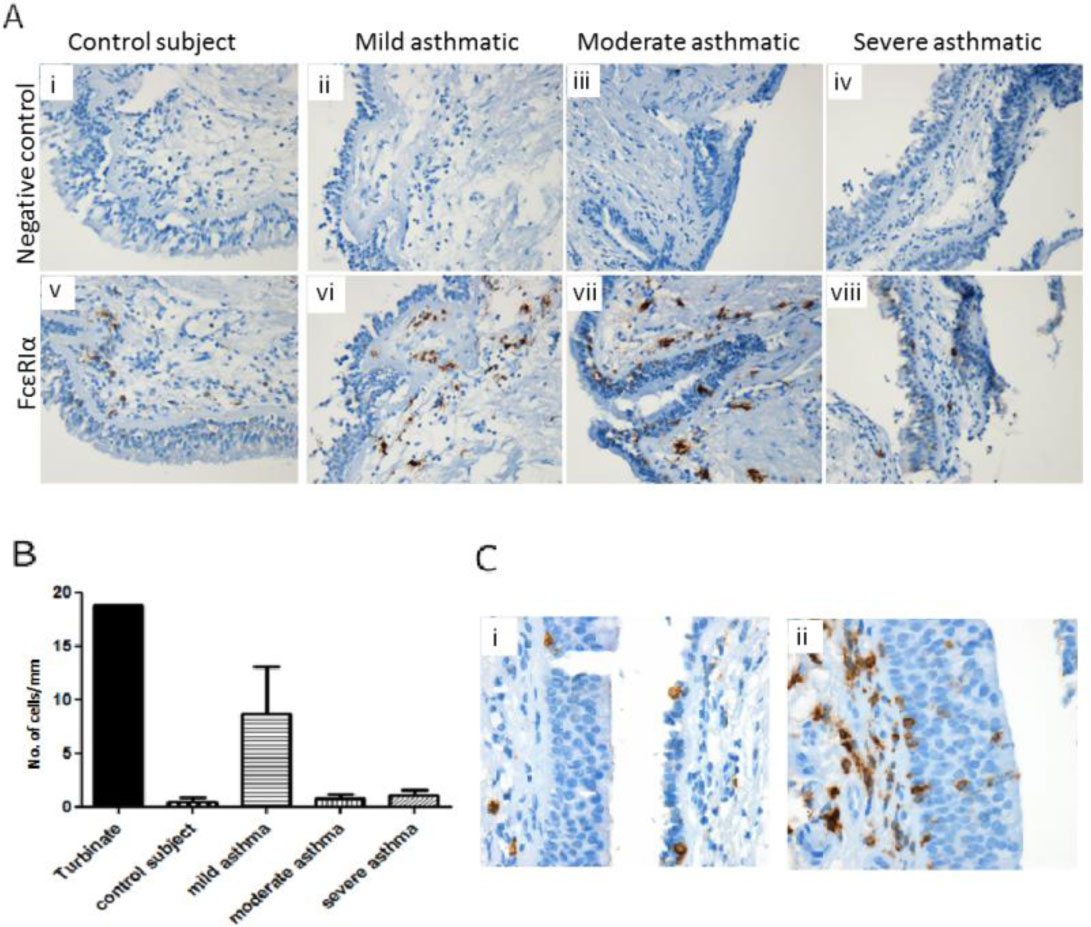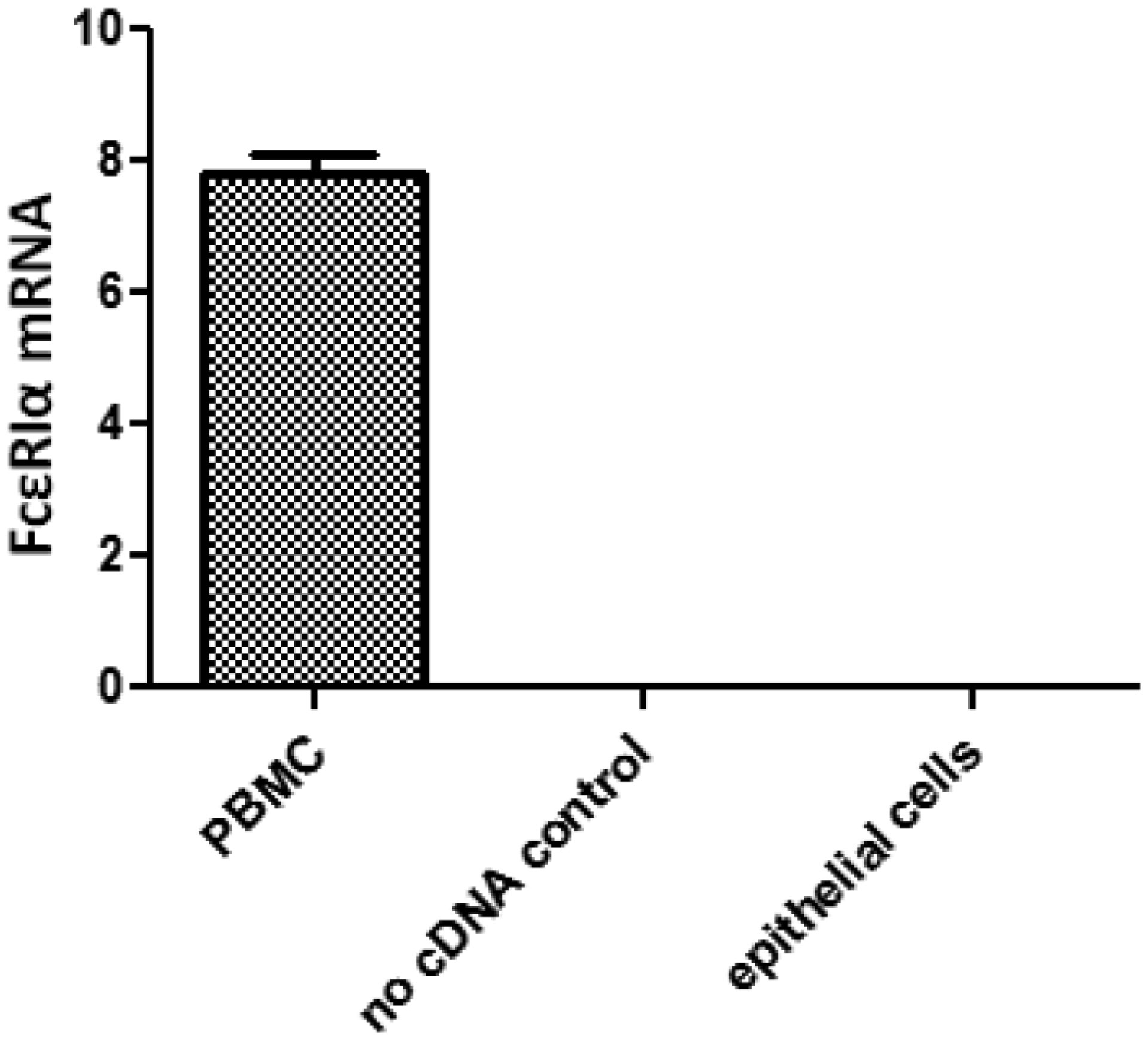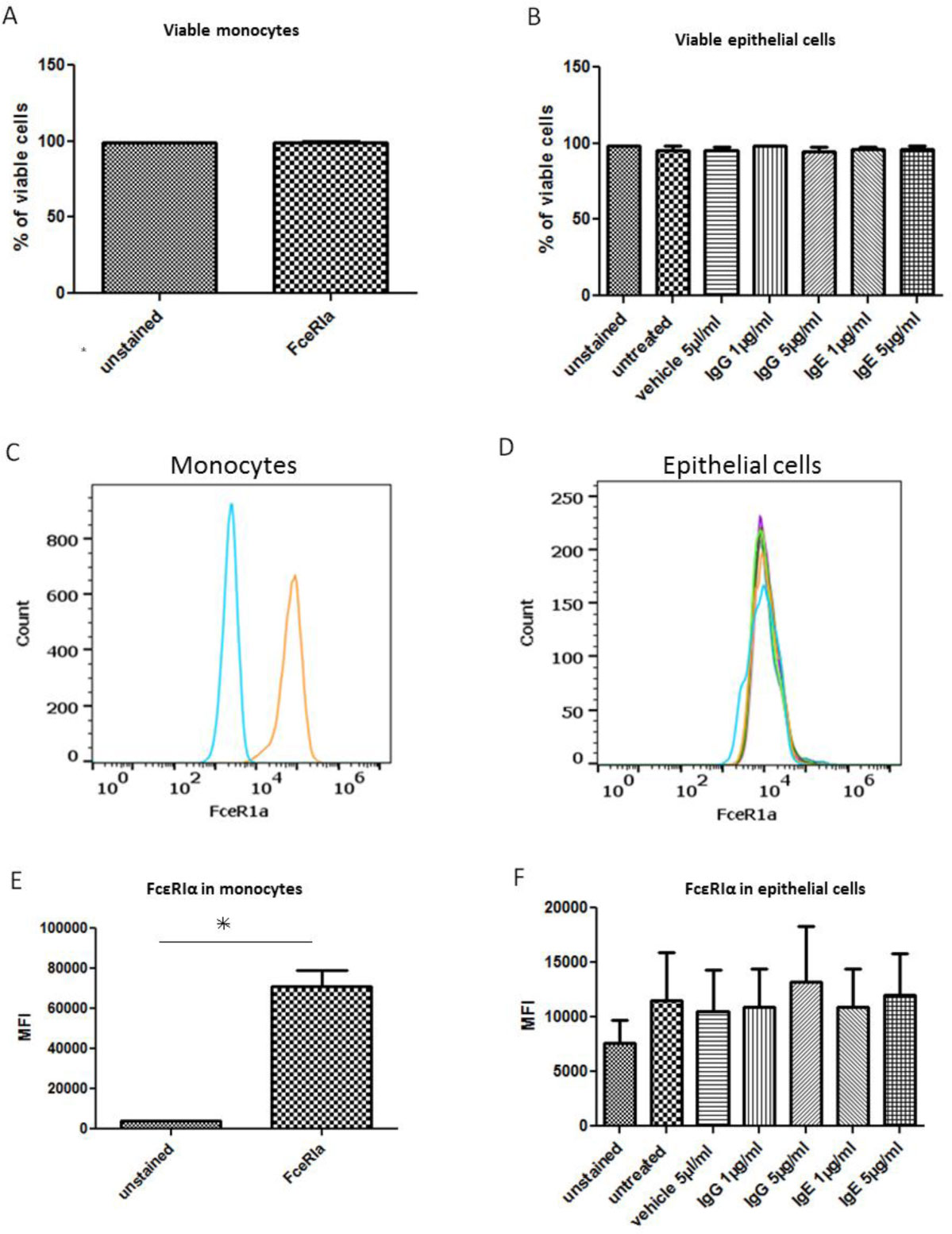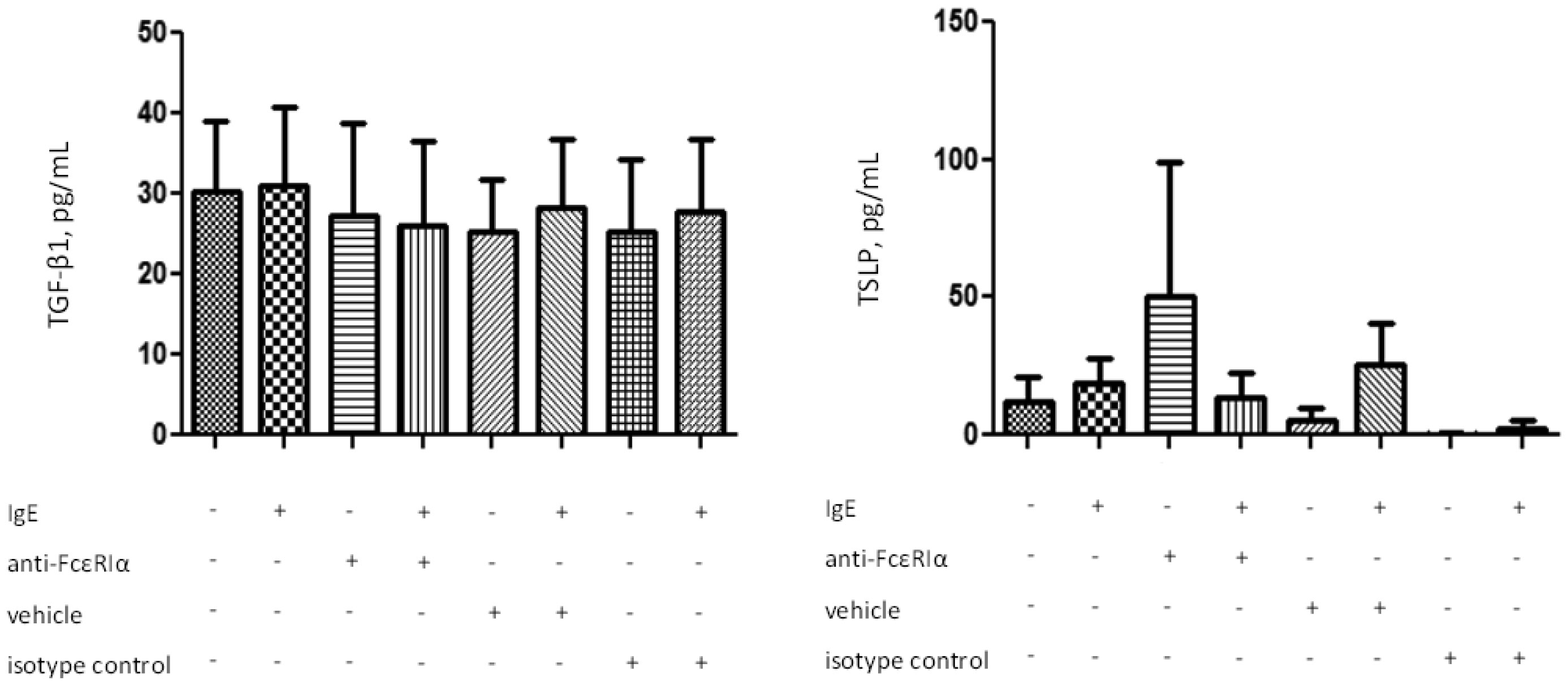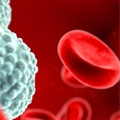1. Introduction
Asthma is a chronic inflammatory disease of multifactorial etiology [1]. The chronic inflammation is associated with progressive remodeling of the airway tissues and bronchial hyperresponsiveness that leads to the clinical manifestations of the disease. These changes include epithelial shedding, reticular basement membrane thickening, goblet cell hyperplasia, smooth muscle hyperplasia and hypertrophy, subepithelial fibrosis and angiogenesis [2,3]. Bronchial epithelial cells are major effector cells in the remodeling process where they secrete profibrotic cytokines and induce fibrotic protein production by fibroblasts [3].
Clinical studies have found a close association between asthma and serum immunoglobulin E (IgE) levels, and the amount of allergen-specific IgE can be dramatically increased in atopic patients [4,5]. IgE plays a major role in airway allergic inflammation and possibly remodeling by regulating a network that involves specific receptors expressed on a broad array of immune cells and also on airway tissue structural cells [6,7,8]. IgE binds to two types of receptors, the high affinity receptor (FcεRI) and the low affinity receptor (FcεRII or CD23) [9]. The high-affinity IgE receptor is constitutively expressed on mast cells and basophils as a tetrameric complex composed of an IgE-binding α subunit, a four-transmembrane-spanning β subunit and two identical disulfide-linked γ subunits [10,11]. In humans, a trimeric complex lacking the γ chain (FcεRIαγ2) also exists and is expressed by the professional antigen-presenting cells (APCs) and a wide variety of other cell types, including airway structural cells [12,13,14]. Each subunit of FcεRI has its own function: The alpha subunit is an immunoglobulin-like chain and contains two domains that bind to the Fc portion of an IgE molecule; the beta subunit amplifies the signal initiated at the gamma subunit; and the gamma subunit is responsible for signal transduction [10]. The low-affinity IgE receptor is transcribed in two sliced isoforms, CD23a and CD23b, with CD23a being constitutively expressed on B cells and CD23b, upon IL-4 activation, on several cell types [15]. IgE regulates the expression of both high- and low-affinity receptors. A direct correlation between total serum IgE levels and FcεRI surface expression has been reported for human basophils, monocytes and dendritic cells (DCs) [16,17,18].
IgE, in addition to its inflammatory role in the pathogenesis of asthma, has recently been suggested to be implicated in airway remodeling. This possibility is supported by evidence suggesting that long-term anti-IgE treatment with omalizumab remains effective long after it has been discontinued [19,20]. Furthermore, the major effect of IgE on remodeling is mediated via FcεRI expression on airway smooth muscle cells (ASMs) and explains the release of collagen type I and -III by these cells, as well as their proliferation [21]. Although FcεRI has also been reported to be expressed on airway epithelial cells [22], the functional significance of IgE produced locally in the bronchial mucosa [11,23] remains elusive. Therefore, we undertook this study aiming to investigate the expression of FcεRI on airway epithelial cells and its possible role to affect airway remodeling in asthmatic patients.
2. Materials and methods
2.1. Characteristics of the human samples
Endobronchial biopsy sections from 10 non-asthmatic, 8 mild, 10 moderate and 17 severe asthmatic subjects were obtained from the Tissue Bank of the Respiratory Health Network of the FRQS. Four patients per group were selected and their clinical characteristics are indicated in the Table 1. For the in vitro experiments, primary human bronchial epithelial cells from two asthmatic donors were used. Cells of the first donor were purchased commercially (Lonza, Walkersville Inc.). Cells of the second donor were isolated in our laboratory. Consent for research was confirmed by the International Institute for the Advancement of Medicine (IIAM) coordinator.
2.2. Cell culture and treatment conditions
Primary human airway epithelial cells were grown in bronchial epithelial cell growth medium (BEGM) (Lonza, Walkersville Inc.) in T75 flasks until cells were ≥ 60% confluent, and then seeded either in T25 flasks or in 6-well plates for flow cytometry or in 12 well plates for ELISA and real-time PCR. For flow cytometry, cells (passage 2-4) were treated with azide-free human IgE (DIA HE1-1, BioPorto) at 1 and 5 µg/ml, mouse IgG (Sigma, Saint-Louis, MO) at 1 and 5 µg/ml, vehicle (phosphate buffered saline (PBS)) at 5 µl/ml in BEGM, or BEGM alone for 24 hours. Cells were treated with accutase enzyme (Millipore, Temecula, CA) at 0.1 ml/cm2 for detachment. For ELISA, cells in 12 well plates were treated for 24 hours with IgE at 5 µg/ml or left untreated. IgE-treated and untreated cells were crosslinked with anti-FcεRIα antibody (BioLegend, San Diego, CA) at 0.5 µg/ml, IgG isotype control (BioLegend, San Diego, CA) at the same concentration, vehicle (PBS) at 0.5 µl/ml, or BEGM alone for 24 hours.
2.3. 3-(4,5-Dimethylthiazol-2-Yl)-2,5-Diphenyltetrazolium Bromide (MTT) test
Vehicle (0.01 M phosphate buffer + 0.09% sodium azide + 0.15 M NaCl) was filtered with a 0.2 µm syringe filter. MTT solution (Sigma, Saint-Louis, MO) was diluted to 5 mg/ml in PBS and filtered using a 0.2 µm syringe filter. Commercially purchased asthmatic human airway epithelial cells were seeded in 96 well plates, using a repeater at 16000 cells in 200 µl BEGM/well and cultured for two days. Seeded cells were treated with either IgE (BioPorto) or vehicle at various concentrations (0.005, 0.05, 0.5 and 5 µg/ml) for 48 or 72 hours. Cells cultured in BEGM alone were used as controls. Four hours prior to the end of the incubation period, MTT solution was added to each well at 1:10 dilution (24 µl/well). After incubation, medium was removed and 100 µl of dimethyl sulfoxide (Sigma, USA) was added to each well. Cells were homogenized for 5 minutes and the optical density of each well was measured using a microplate reader set at 550 nm. The optical density readout was subtracted from that of the treatment condition and normalized to the cells cultured in BEGM alone, which was considered as 100% viable.
Table 1. Subjects' characteristics.
| Severity |
Gender |
Age |
Age of onset |
Atopic |
IgE (UI/mL) |
Weight (KG) |
Height (M) |
FEV1 (L, %) |
FEV/FVC |
Allergens |
Medications taken |
| control |
F |
20 |
|
NO |
N/A |
137 |
1.61 |
2.93, 100% |
0.78 |
|
|
| control |
F |
19 |
|
NO |
N/A |
N/A |
1.68 |
2.82, 81 |
0.77 |
|
|
| control |
F |
27 |
|
NO |
N/A |
59 |
1.68 |
3.56, 102 |
0.81 |
|
|
| control |
M |
29 |
|
NO |
N/A |
105 |
1.83 |
5.39, 115 |
0.84 |
|
|
| mild |
M |
22 |
N/A |
YES |
N/A |
75 |
1.78 |
3.73, 80 |
0.71 |
Dog hair, cat skin, grass, ragweed, weeds, dust |
Ventolin |
| mild |
M |
29 |
15 |
YES |
N/A |
N/A |
1.8 |
4.23, 92 |
0.78 |
Cat, dog and horse hair, mite |
Ventolin |
| mild |
F |
30 |
23 |
YES |
N/A |
N/A |
1.64 |
3.18, 96 |
0.92 |
Cat hair, trees, ragweed, weeds |
Terbutaline, Depo Provera, Ritalin |
| mild |
M |
25 |
14 |
YES |
N/A |
95.5 |
1.82 |
4.03, 84 |
0.79 |
Cat skin, horse hair, ragweed, D. farinae, D. ptéronyssinus |
Ventolin |
| moderate |
F |
31 |
30 |
YES |
N/A |
63 |
1.6 |
2.65, 85 |
0.76 |
Grass, Alternaria. |
Terbutaline, Budesonide. |
| moderate |
F |
26 |
N/A |
YES |
90 |
54.3 |
1.6 |
3.11, 96 |
0.85 |
Cat hair, mould, dust |
Ventolin, Fluticasone |
| moderate |
F |
30 |
N/A |
YES |
N/A |
105 |
1.72 |
3.18, 74 |
0.71 |
Cat hair, dog hair, horse hair, grass, ragweed, D. farinae, D. ptéronyssinus |
Ventolin, Symbicort |
| moderate |
M |
37 |
5 |
YES |
N/A |
N/A |
1.78 |
4.31, 101 |
0.85 |
Cat hair, dog hair, mold, grass, ragweed, D. farinae |
Ventolin, Advair HFA250 |
| severe |
M |
35 |
3 |
YES |
625 |
105 |
1.80 |
3.10, 69 |
0.86 |
Trees, grass, weeds, dust |
Singulair, Spiriva, Ventolin, Oral Corticosteroids, Advair Diskus 250, Methotrexate |
| severe |
M |
29 |
1 |
YES |
N/A |
85 |
1.77 |
2.62, 59 |
0.63 |
Aspergillus fumigatus, D. farinae, D. ptéronyssinus |
Ventolin, Advair Diskus 500 |
| severe |
M |
39 |
34 |
YES |
N/A |
77 |
1.7 |
2.73, 70 |
0.66 |
Grass, Alternaria |
Singulair, Alvesco, Ventolin, Nasal steroids, advair Diskus 500, Prednisone |
| severe |
M |
35 |
1 |
YES |
N/A |
N/A |
1.63 |
1.45, 40 |
0.53 |
Cat hair, dog hair, horse hair, grass, ragweed, trees, house dust |
Ventolin, Alvesco, Advair diskus 500 |
2.4. Immunohistochemistry (IHC)
Bronchial biopsy sections were stained using the Ventana Discovery autostainer. Briefly, the process began with a deparaffinization step using a Triton-based buffer, followed by an antigen retrieval step using an ethylenediaminetetraacetic acid (EDTA)-like buffer, then a blocking step using a serum-free blocking buffer (Dako), and blocking of endogenous peroxidase activity. Mouse anti-FcεRIα antibody at a dilution of 1:200 (clone 9E1, Abcam, Toronto, ON) was manually added and the Ventana autostainer diluted the applied antibody 5 times to a final dilution of 1:1000. Further staining procedure included application of Hapten (HQ)-conjugated and horseradish peroxidase (HRP)-conjugated anti-HQ antibodies and color development using 3,3′-Diaminobenzidine substrate. Counterstaining was done with hematoxylin and a bluing reagent, and slides were washed and mounted. A biopsy tissue of the inferior turbinate of an allergic rhinitis subject was used as a positive control. Negative controls were prepared by using isotype matched mouse IgG (Cedarlane, Burlington, ON) as the primary antibody or by the omission of the primary antibody from the staining process.
2.5. Flow Cytometry (FACS)
Cells were washed with PBS and detached from the flask using accutase enzyme [24] at 0.1 ml/cm2 concentration for 10 minutes at 37 °C in an incubator. Following detachment, cells were transferred to 15 ml tubes for centrifugation and supernatants were removed. Cells were then transferred into FACS tubes, washed with PBS and stained with viability dye (efluor660) (eBioSciences, Affymetrix, San Diego, USA) at 0.1 µl/100 µl of PBS. Cells were incubated in the dark for 15 minutes at room temperature. Cells were washed with PBS-bovine serum albumin (BSA) (0.2%) and incubated in the dark with rabbit anti-FcεRIα antibody (EMD Millipore, Etobicoke, ON) diluted in PBS-BSA (0.2%) for 30 minutes at 4 °C. Cells were washed and incubated in the dark with a goat anti-rabbit Alexa Fluor® 488 conjugated antibody (Molecular Probes, Life Technology) at 4 °C for 30 minutes. Cells were washed and passed through a filter for disaggregation. Stained cells were read using the flow cytometer Accuri C6 machine and results were analyzed using the FlowJo software. Human monocyte cell lines (U937 and THP-1) were used as positive controls. Cells stained without the primary antibody was used as the negative control. Viability dye compensation control was produced by killing 250,000 monocytes by incubating them in a dry bath at 65 °C for 15 minutes. Killed cells were mixed with the same number of live cells. Cells were washed with PBS and stained with viability dye only. No primary or secondary antibodies were added to the viability dye compensation control. Alexafluor488 compensation control was prepared using positive and negative beads.
2.6. Real-time PCR
Primers specific to the alpha subunit of FcεRI (FcεRIα) were purchased from Life Technology and human GAPDH primers were kindly provided by Dr. Baglole. Primer sequences are listed in the Table 2. RNA extraction was done using NucleoSpin® RNA extraction kit (Clontech, Takara Bio Group, Germany) according to the manufacturer's instructions. Immediately after extraction, RNA purity and concentration were determined by spectrophotometry using the Epoch Spectrophotometer System. Aliquots were prepared to measure RNA purity, quality and concentration using Experion™ RNA StdSens kit (Bio-Rad, Mississauga, ON) according to the supplier's manual. 400 ng of RNA from each sample were then reverse transcribed to cDNA using iScript reverse transcription kit (Bio-Rad, Mississauga, ON) and nexus machine according to the supplier's manual. cDNA was stored at −20 °C until the day of the experiment. Thermal gradient test was done to determine the optimal annealing temperature of the primers. Human peripheral blood mononuclear cells (PBMC) were used as the positive control; reaction mix without cDNA was used as the negative control; and human GAPDH primers were used as the house keeping gene. The annealing step of the PCR was set at 6 temperatures (52, 54, 56, 58, 60 and 62 °C) for each primer pair (FcεRIα and hGAPDH) and the optimal annealing temperature was determined to be 60 °C for both genes. The experiment was done using the StepOnePlus Real-Time PCR System. Standard curve was generated to determine primer efficiency with 8 points at 1:2 dilution series starting from no dilution in triplicates. Experimental procedure and controls were done as described above. The primers were tested on the positive control only since no expression of FcεRIα was detected on epithelial cells as determined by the thermal gradient. Mean quantitation cycle (Cq) value of each point was plotted against the log10 of its dilution. Slopes of the plots were used to determine reaction efficiency of the primers using QPCR Standard Curve Slope to Efficiency Calculator. Reaction efficiency was 90.66% for the FcεRIα primers and 96.14% for the hGAPDH primers. The samples were run on the real-time PCR machine using the same experimental procedure and controls as described above in the thermal gradient experiment.
Table 2. Primer sequences used in real-time PCR.
| FcεRIαF |
CTCCATTACAAATGCCACAGTTG |
| FcεRIαR |
CACGCGGAGCTTTTATTACAGTA |
| hGAPDHF |
GTCTCCTCTGACTTCAACAGC |
| hGAPDHR |
ACCACCCTGTTGCTGTAGCCA |
2.7. Enzyme-linked immunosorbent assay (ELISA)
Cell-conditioned media were collected from the bronchial epithelial cells subjected to IgE treatment for 24 hours, centrifuged at 2000 rpm for 10 minutes at 4 °C and cell-free supernatants were stored in aliquots at −80 °C. TGF-β1 and TSLP ELISA kits were purchased from R & D systems (Minneapolis, MN 55413, USA). ELISA was done according to the manufacturer's protocol.
2.8. Statistical analysis
One way ANOVA and t-tests were used to assess the statistical significance among experimental groups using the software GraphPad Prism 5.
3. Results
3.1. Little or no expression of FcεRI in human bronchial epithelial cells
In order to validate the expression of FcεRI in human bronchial epithelial cells, the in situ expression of FcεRI in bronchial biopsy tissues of asthmatics of varying severity and control subjects, and in vitro expression of FcεRI in primary human bronchial epithelial cells from asthmatic subjects were determined. Immunohistochemical analysis of in situ expression of FcεRI revealed a very small number of FcεRIα+ cells in the epithelium of the bronchial biopsy samples (Figure 1A). When quantified, there was no significant difference among the different groups; however, the number of FcεRIα+ cells in the epithelium per unit length of the basement membrane was higher in mild asthmatic subjects as compared to other groups (Figure 1B). Staining of serial sections of a bronchial biopsy from an asthmatic subject, with FcεRIα and CD45, common marker for hematopoietic cells and their precursors, including mast cells and basophils, detected the presence of CD45+ cells in the epithelium, suggesting to other than epithelial cells expressing FcεRIα (Figure 1C).
In order to get a more clear assessment of FcεRIα expression in primary bronchial epithelial cells, we performed quantitative RT-PCR analysis of FcεRIα mRNA on two bronchial epithelial cell lines from asthmatic subjects. PBMC were used as a positive control. No mRNA expression of FcεRIα was detected in these bronchial epithelial cells (Figure 2). Furthermore, these results were in accordance with no detectable in vitro expression of FcεRIα in the primary bronchial epithelial cells from the same two asthmatic donors when assessed by flow cytometry (Figures 3D, F). Taken together, our results indicated little to no baseline expression of FcεRI at the protein and mRNA levels in bronchial epithelial cells.
3.2. IgE did not upregulate FcεRI expression in primary bronchial epithelial cells of asthmatic subjects
As the primary bronchial epithelial cells from asthmatic subjects lacked the expression of FcεRI at baseline level, we then determined the role of IgE on FcεRI expression in these cells. Bronchial epithelial cells were treated with IgE at 1 and 5 µg/ml for 24 hours based on a published report that a concentration between 1 and 5 µg/ml (1.5 µg/ml) successfully upregulated FcεRI in rat basophilic leukemia cells and the highest amount of the receptor was found at a time point between 24 and 28 hours [25]. Mouse IgG was used as a negative control for IgE treatment. Epithelial cells treated with azide-containing IgE had greatly reduced viability and MTT assays demonstrated that cell viability was decreased after treatment with either azide-containing IgE or azide-containing vehicle in a time- and dose-dependent manner, p < 0.05. Hence, subsequent experiments were done using azide-free human IgE. U937 cells were used as a positive control for FcεRIα expression with 99% viability (Figure 3A) and positive FcεRIα expression (Figures 3C, E). Epithelial cells treated with azide-free human IgE, mouse IgG or vehicle remained viable (Figure 3B) but did not express significantly higher FcεRIα as compared to the control cells (Figures 3D, F; p = 0.2), suggesting the lack of upregulation of FcεRI expression in bronchial epithelial cells following stimulation with IgE.
3.3. Crosslinking of FcεRI did not increase the release of TGF-β1 or TSLP from primary bronchial epithelial cells of asthmatic subjects
Some of the downstream effects of IgE signaling involve the release of TGF-β1 and TSLP cytokines [26,27,28]. Therefore, to confirm the presence/absence of a functional FcεRI receptor we were interested to investigate the expression of these cytokines in the cell culture supernatants upon crosslinking of FcεRI with an antibody. The bronchial epithelial cells were stimulated with 5 µg/ml of IgE for 24 hours, and/or 0.5 µg/ml anti-FcεRIα antibody for another 24 hours. The cell supernatants were collected post-treatment to analyze the expression of TGF-β1 and TSLP cytokines by ELISA. No significant differences in the protein levels of TGF-β1 (Figure 4A; p = 0.1) or TSLP (Figure 4B; p = 0.3) were observed under the various stimulation schemes as compared to the unstimulated cells. Thus, IgE signaling through the FcεRI receptor did not appear to induce the expression of these cytokines from bronchial epithelial cells.
4. Discussion
The activation of the allergic cascade by IgE, under constant allergen stimulation, leads to the establishment of chronic allergic inflammation in the airways of asthmatic patients, with IgE being a key element of the vicious circle that maintains it. Given the likely inflammatory component involved in the development and maintenance of airway remodeling, and because IgE is central to allergic inflammation, it is conceivable that anti-IgE therapy may influence the remodeling process. To explore this hypothesis, in this study we investigated whether bronchial epithelial cells express FcεRI and its functionality directly affects airway remodeling in asthmatic patients. Our data suggested that bronchial epithelial cells do not express high affinity receptor FcεRI.
A number of studies have assessed the efficacy and safety of anti-IgE therapy such as omalizumab in asthma [29]. Omalizumab acts by reducing serum-free IgE and expression of FcεRI, thereby reducing the amount of IgE binding to mast cells, basophils, and eosinophils [7,30]. This prevents the degranulation of allergen-bound mast cells, which would otherwise result in the release of proinflammatory cytokines (including IL-4, IL-5, and IL-13) associated with airway remodeling. Prevention of this step also has the potential to limit subsequent eosinophilia and further IgE production [31]. Another mechanism by which anti-IgE may affect inflammatory cells and mediators is through inhibition of antigen processing and presentation to T cells by downregulating FcεRI expression on APCs such as DCs [16,32]. Taken together, anti-IgE therapy prevents the production of proinflammatory cytokines and growth factors, and as a result contributes to decreased airway remodeling [33].
However, IgE might also be directly associated with airway remodeling [13,21,34,35]. Notably, human ASMs may play a major role in this by expression of both low- and high-affinity IgE receptors, through which IgE can modulate cellular contraction and inflammatory mediator synthesis, such as IL-4, IL-5, and IL-13 [34,35]. Interestingly, pretreatment with omalizumab significantly inhibited in a dose-dependent manner IgE-mediated ASMC proliferation and extracellular matrix and collagen deposition [13,21], suggesting a probable mechanism underlying the therapeutic effect of omalizumab to curtail airway remodeling. These invitro findings were corroborated by two clinical studies investigating the potential effects of omalizumab on the airway wall using computed tomography imaging in a limited number of patients with allergic asthma [36,37]. In fact, omalizumab significantly decreased the airway wall area, the percentage of wall area, and the luminal area of the right apical bronchial segments, whereas no change was achieved with conventional therapy [36]. This would be in accordance with previous studies dissociating chronic inflammation from airway structural changes. Indeed, increased reticular basement membrane thickness has been reported as early as 1 year of age in preschool-aged children with wheeze [38] and even within 8 days in response to inhaled allergens in mild asthmatics [39]. These findings indicate that omalizumab may modify the course of the disease due to its possible direct influence on curtailing airway remodeling.
Given that FcεRI has been reported to be expressed on bronchial epithelial cells [22], it is plausible that IgE may mediate the remodeling process via epithelial cells. However, we could not confirm the expression of FcεRI in human bronchial epithelial cells, as previously reported in the literature. Our data suggest that anti-IgE therapy likely has no effect on bronchial epithelial cells that is mediated through FcεRI.
Our findings are in contrast with previous study reporting FcεRI expression by human bronchial epithelial cells using RT- PCR and immunohistochemistry [22]. Several factors could explain the discrepancy of these results. The former study used immunohistochemistry to detect FcεRI expression in epithelial cells and they are known to have non-specific staining which may have produced false-positive results. Moreover, the PCR data did not correlate strongly with the immunohistochemistry data. The band corresponding to the alpha subunit of FcεRI in the PCR data was much brighter than that of the housekeeping gene (GAPDH) in most of the control subjects, yet the IHC data showed FcεRI expression in only half of the asthmatic subjects. In addition, there was no clear counterstaining shown in the tissue sections. In our study, we investigated the expression of FcεRI on bronchial epithelial cells from both the control and asthmatic subjects and validated the negative results using various techniques such as immunohistochemistry, flow cytometry and PCR. Furthermore, treatment with IgE is expected to upregulate the level of FcεRI on the cell surface provided that there is ongoing synthesis of the receptor subunits inside the cell at a baseline level [40]. Importantly, absence of FcεRI on bronchial epithelial cells even after stimulation with IgE in our study further confirmed the lack of FcεRI expression already at a baseline level. Along this line, in the above study by Campbell et al., the epithelial cells were obtained from bronchial brushing with less than 50% viability for both the allergic asthmatic and control cells (16% and 43%, respectively) [22]. In contrast, the mean cell viability in our study was close to 100% for the various experiments (Figure 3B). In conclusion, there is no evidence that human bronchial epithelial cells express FcεRI. Our data suggest that anti-IgE therapy likely has no effect that is mediated through FcεRI on bronchial epithelial cells.
An absence of FcεRI on human airway epithelial cells, as our results suggest, does not imply that there is no interaction between IgE and airway epithelial cells. Given the inability of the damaged bronchial epithelium to act as a barrier in severe asthmatics, it is possible for both allergens and IgE to penetrate and directly reach resident tissue-forming cells. In fact, low affinity receptor FcεRII has been shown to be expressed on airway epithelial cells in vitro [41] and to mediate transcytosis of IgE or immune complex (IgE plus antigen) [42]. Hence, FcεRII could play a role in asthma by increasing the availability of allergens to the infiltrating immune cells in the submucosa. Interestingly, a proteomic analysis of bronchial biopsies on eight severe asthmatics demonstrated that administration of omalizumab for 1 year downregulated bronchial smooth muscle proteins, with galectin-3 being the most reliable and predictive biomarker of airway remodeling modulation by this treatment [43].
5. Conclusion
Our study demonstrated negligible expression of the high affinity FcεRI receptor in human bronchial epithelial biopsies and primary human epithelial cells at the protein and mRNA levels. No baseline expression of FcεRI in bronchial epithelial cells could contribute to the lack of upregulation of these receptors when stimulated with IgE. Furthermore, crosslinking the FcεRI receptor with corresponding antibodies failed to induce the release of cytokines such as TGF-β1 and TSLP, which have been implicated in the airway remodeling process. Further studies are needed to delineate the exact mechanisms through which anti-IgE treatment benefits patients with severe allergic asthma as well as to identify novel therapeutic indications.
Acknowledgements
This study was supported by Richard and Edith Strauss Canada Foundation. The authors thank the staff at the Biobank of the Respiratory Health Network, RI-MUHC Meakins-Christie Laboratories site.
Conflict of interest
All authors declare that they have no conflict of interest in this paper.









 DownLoad:
DownLoad: 